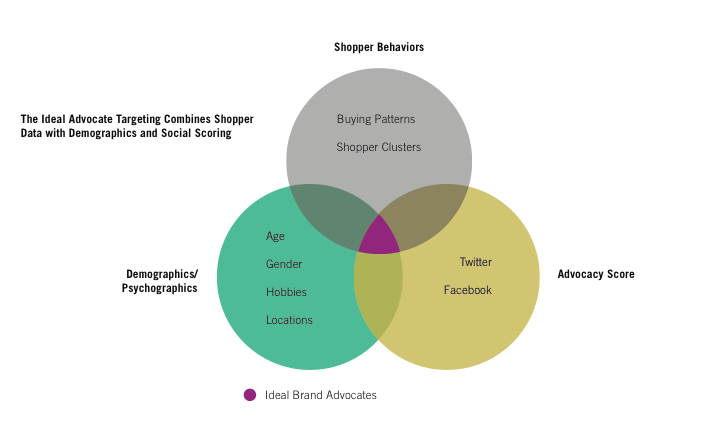By adaptive - April 22nd, 2013
In the concluding part of this series we consider given it’s rapid trajectory, it’s likely that brand advocacy will continue to develop in the future,just as other forms of social media marketing has.
The important questions for marketers are the direction that this will take: what will be the drivers, and how should businesses position themselves to take full advantage of these brand ambassadors?
Any consideration of the future state of brand advocacy needs to be grounded in an understanding of its current role in marketing. One difficulty here is that at present, advocacy has so many different manifestations.
For some businesses, it’s all about having a large and interactive Facebook presence where customers and potential customers share information and opinions, and where the business can reward customer loyalty.
At a different extreme are advocate communities, which have some – largely superficial – independence from the ‘host business’: the Fiskateers and Wallmart Moms come to mind here. For other businesses, active user groups offer a medium through which advocates share opinions, advice and information – and which can sometimes provide useful pointers towards product development.
All of these advocate models have room for future development, and it’s unlikely that any one will emerge as the sole paradigm for the marketers of the future. It’s much more likely that businesses will opt for the best approach for their individual market, or perhaps develop hybrids, which include a range of opportunities for social interaction.
What’s certain is that the importance of brand advocacy will continue to grow, if only because of the changes that social media have already caused in customer behaviour. Molly Flatt, Word-of-mouth Evangelist with specialist agency 1000heads says that one change that businesses should recognise is that “most consumers have lost trust in conventional marketing messages. They also recognise that social media has given them a voice, and also the confidence to talk openly to both friends and strangers about brand choices.”
Impulse buying becomes a thing of the past
An interesting effect of this consumer interaction – perhaps that should be intra-action, as it often excludes brand owners – is that impulse buying may well become a thing of the past. Instead of seeing an ad, a poster or a product in a shop and making a decision to buy, consumers are far more likely to get the opinion of other users and make a buying decision based at least in part on that opinion.
Some of the research that’s been conducted on this issue over the past couple of years has had startling results. For example, a Yahoo/Universal McCann study quoted in the dunnhumby e-book Open your doors to advocacy found that 55% of shoppers are less impulsive as a result of social media: “Even the smallest purchase is thoroughly researched before a consumer heads into your online or bricks and mortar store to buy…Discussing features and the differences in models with others helps them learn about the product from someone they trust”.
Shopper information can be leveraged into an advocacy program that can drive sales.

[http://www.dunnhumby.com/insight/open-your-doors-to-advocacy-ebook/]
Leading on from this is the need for brand owners to gain real knowledge of consumers and potential customers, and to understand the motivations and attitudes of potential advocates. Malcolm Faulds, Senior Vice President, Marketing for Bzzagent, the social marketing agency owned by dunnhumby, cautions that companies should not see advocacy simply as building a collection of Facebook Likes or Twitter Followers. “It’s not what advocacy is all about,” he says. “Having someone ‘like’ a product or company on Facebook is just the first step in a long process.”
He goes on to insist that the future of brand advocacy lies in companies cultivating their own communities of advocates. To a very large extent, this involves coming to terms with the idea that advocates will increasingly recognise their own value to brands: “It’s an interesting psychological perspective that advocates want to share their views, and want their voices to be heard – it’s a way of increasing self-worth.”
Powerful consumer voices
Molly Flatt of 1000heads agrees that consumers are increasingly aware of the power of their voice, but she cautions that businesses need to be aware of cultural differences. “American consumers are much more gung ho about being involved with brands, and consumers enjoy being part of a brand family. In general, Europeans prefer to maintain a greater degree of independence, although their advocacy role is just as important.” She also says that businesses need to recognise the importance of ‘real world’ advocacy: “Research by Keller Fay has shown that 90% of word-of-mouth advocacy is offline. The really valuable stuff happens over the dinner table or round the coffee machine - social media just accelerates it.”
Of course, it’s much harder to track offline advocacy, although social media metrics give a reasonable measure. All of the major word-of-mouth and advocacy specialists have ways of interpreting the effect of consumer activism. And as Malcolm Faulds of BzzAgent points out, as brand owners become more confident about the power of advocacy, budgets will increase: “This will happen when businesses recognise that there is a residual value to advocacy which gives it a unique advantage compared with conventional marketing.”
He points to interesting parallels with the development in the late 1990s of search marketing. “When Overture came up with the idea of search marketing, it brought brands into the bottom of the search funnel – in other words, linking brands to searches. Something similar needs to happen with advocacy, bringing the process into conventional marketing, and that will lead people to do more.”
The integration of brand advocacy into mainstream marketing seems inevitable. Rob Fugetta, Founder and CEO of Zuberance and author of Brand Advocates: Turning Enthusiastic Customers into a Powerful Marketing Force echoes the view that there has been a shift in power from marketers to social media-powered advocates: “It is not a fad or short-term phenomenon. It’s a sea change in marketing [and] I predict that within a few years advocate marketing will be as much a part of the marketing landscape as search engine marketing or email marketing are today.”
It may well be that brand advocacy represents the golden key that will unlock the potential benefits of social media for businesses. Clearly we are not there yet and, as with some other misuses of social marketing, there’s plenty of room for disastrous decision-making. However, it’s also clear that bringing consumers into conversation and facilitating discussion about products or services can have enormous benefits. The successful brands of the future will be those that listen to customers, and react accordingly.
Molly Flatt, Word-of-mouth Evangelist with specialist agency 1000heads

Malcolm Faulds, Senior Vice President, Marketing for Bzzagent

Next Reads
October 2013, New York
How you can leverage social media for a more effective customer service function and better customer insight
Brochure Programme